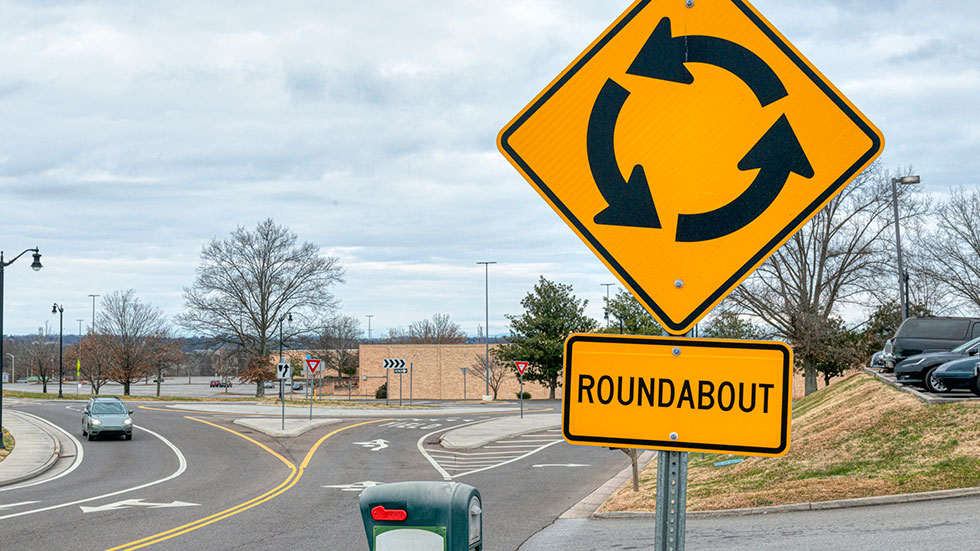

Somewhere, some agency, official, or scientist decided there needed to be more traffic circles or modern roundabouts in our lives.
It seems, roundabouts have popped up everywhere in the last couple of years, replacing highway on-and off-ramps, city intersections, and rural four-way stops.
Roundabouts are used to slow traffic speed in a neighborhood, reduce T-bone crashes that can happen at traditional intersections, and to handle traffic volume more efficiently. To use modern jargon, traffic circles and roundabouts facilitate better traffic flow.
It forces drivers to slow down before entering the intersection, among other things. In fact, the Federal Highway Administration says roundabouts reduce crashes that cause serious injury.

I understand that many people, transportation experts, and officials fully support traffic circles. I also understand that in Europe, they’re common, and even tiny children know how to use them.
I am none of the above. I am very bad at traffic circles and roundabouts. I do not have statistics to back me up. All I have is observation, stark terror, and lingering confusion. Keep in mind that no math was harmed in the forming of this opinion.
I understand traffic circles logically, but emotionally, not so much. I was concerned I was alone in my roundabout panic, but an unscientific, unverifiable poll of my friends shows that many of us are dazed and confused.
I asked my Facebook friends to finish this sentence. Traffic circles are ___. The printable answers included hell, trash, great, and efficient. One joker said traffic circles are, uh, round. Several replied that traffic circles are accidents waiting to happen. My personal favorite answer was the friend who answered with the poo emoji.
Actually, most people agree that roundabouts are great if you know how to use them correctly. That’s the problem. No one consistently knows how to navigate the modern roundabout. They didn’t teach it in twentieth-century driver’s ed. Or maybe I missed that day.
First, there’s entering the circle. Drivers must yield to the cars already in the circle. This sounds simple, but in reality, it feels like leaping into a high-speed double-Dutch jump rope session. They do not stop the jump rope for you. So, yeah, just pop right in there between those other cars that are circling and randomly changing lanes. No big deal!
Then there’s the signage. Let’s break it down. There’s a squiggle circle with the dot and an arrow next to the other squiggle circle with the dot and the arrow. Shoot. What did that indicate?

Since you’re constantly moving in the circle, you can’t digest what the sign means in time to act on it. So, you circle again. I’ve been known to stay in my lane and go around the horn while I process the sign’s message.
The instructional videos recommend drivers decide where they’re going before getting into the circle. This means you need to choose a lane upon entering and then maintain it. K’?
And beware, if you switch lanes, you might get wedged under a semi. I’ve seen this happen three times. Three. You might be diligently maintaining your lane, but that driver next to you is confused too, and they’re coming in hot. There, for the grace of Dodge go I!
An exit two counties north of me installed four roundabouts. I no longer go there. I want to. They’ve got a Kohl’s and a T.J. Maxx! That’s good shopping. My kind of shopping. But the multiple roundabouts make me feel like a knife thrower’s assistant, strapped to a wheel, and the knife thrower is drunk, blindfolded, throwing knives at me, and also driving a semi that’s on fire while trying to find their Kohl’s Cash in the glove box.
A sale on athleisure isn’t worth my life.
Many of my very intelligent friends love roundabouts. So, I am trying to develop the necessary skills. While others vowed to get in shape or exercise for the new year, my resolution was to get marginally better at navigating roundabouts. I am on TikTok. For goodness sake, I can learn this too.
Next, stop or go, or stop? The diverging diamond-style highway entrance and exit! As Dodge as my witness! I’ll never be honked at again!
In case you’re looking for the specifics on how to tackle a roundabout, here is what the American Association of State Highway Transportation recommends.
SINGLE-LANE ROUNDABOUTS
- As you approach the roundabout, slow down and scan for pedestrians and bicyclists crossing the street.
- Keep an eye out for signs, including a recommended speed limit, a one-way sign and dashed lines that indicate the roundabout entrance.
- Yield to traffic already inside the circle. Look for cars coming from your left and do not proceed until it is safe to do so.
- Drive the recommended speed limit and use a turn signal before you exit. Turn left by traveling counterclockwise around the center island. When you reach your desired exit, turn right to exit. Remember to signal.
MULTI-LANE ROUNDABOUTS
- Look for signs that describe your lane choices. They resemble those indicating turn lanes at traditional intersections.
- Yield to both or all lanes of traffic before entering the intersection.
- Drive in the innermost lane until you are ready to exit. Remember to signal. You may have the option to exit from several lanes, but if you must switch lanes to get out, use caution and scan for traffic to your right before moving over.
- Look for pedestrians and bicyclists as you leave the roundabout.
